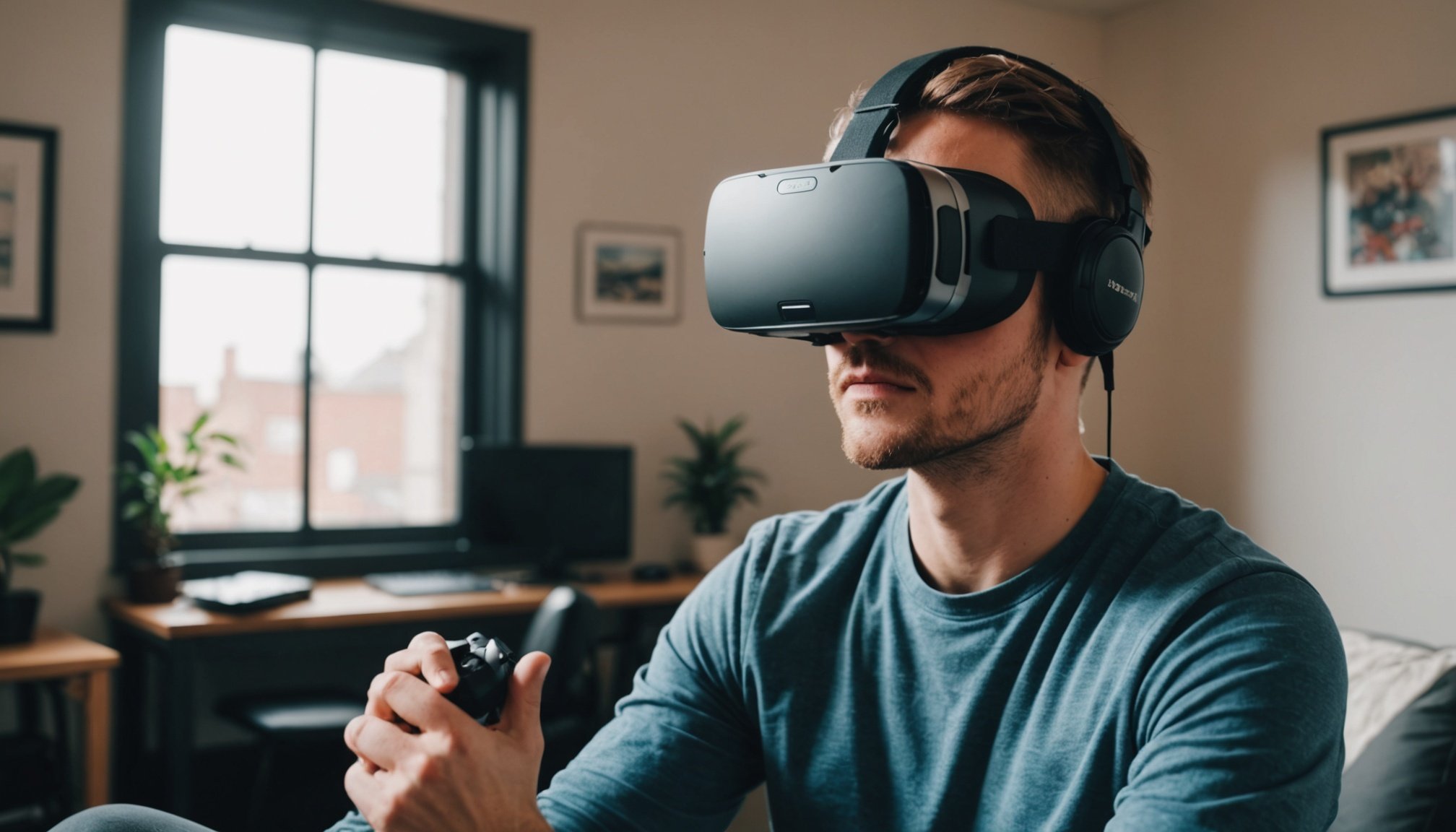Overview of Virtual Reality in Mental Health Therapy
Virtual Reality (VR) is emerging as a powerful tool in mental health therapy, revolutionising therapeutic settings. By creating immersive, simulated environments, VR offers a unique way to engage patients, making traditional therapeutic approaches more effective.
In therapeutic contexts, VR’s purpose is to provide a safe space where individuals can face and manage their mental health challenges. It enables exposure therapy, helping treat issues like PTSD or phobias by gradually exposing patients to their fears in a controlled manner. The interactive nature of therapeutic games designed for VR facilitates active involvement in therapy, enhancing engagement and potentially speeding up recovery.
In the same genre : Essential Factors for Crafting Intuitive Heads-Up Displays (HUDs) in FPS Games: A Comprehensive Guide
The benefits of using VR for mental health interventions are manifold. It offers controlled environments for therapy, allows for anonymity, and can be tailored to individual needs, making it a flexible option. Furthermore, VR can make therapy more accessible to those who might have difficulty accessing conventional therapy settings.
An array of therapeutic games have been developed for use in VR. These games often target specific mental health issues, such as anxiety reduction or cognitive behavioural therapy support, by using game mechanics to encourage positive behavioural changes.
Topic to read : Top Techniques to Reduce Input Lag in Competitive Console Gaming for Optimal Performance
Essential Safety Protocols for VR Use
Navigating Safety Protocols in virtual reality therapy is crucial to ensure a secure and effective experience. A primary focus should be on establishing a safe therapy environment. This involves conducting a thorough assessment of the physical space and ensuring it’s free from obstacles. Adjust furniture to create an area where users can move freely without risking collision with objects.
Implementing comprehensive VR Therapy Guidelines enhances user comfort and safety. Prior to each session, a pre-assessment of patient comfort can identify potential issues, such as motion sickness or discomfort with VR headsets. Customizing the experience to suit individual physical and psychological needs is vital. This minimizes adverse effects and enhances therapy outcomes.
Managing hazards is not limited to the physical environment. Equipment hazards should be meticulously addressed. Regular checks of VR headsets, controllers, and sensors are necessary to confirm they’re in optimal working condition. Ensuring that cables do not pose tripping risks is part of a proactive safety management strategy.
Continually updating the therapy space and equipment based on these protocols will significantly improve user experiences. By prioritising safety, therapists can create a supportive setting conducive to effective VR therapy sessions, ultimately enhancing treatment efficacy and patient satisfaction.
Addressing Potential Risks and Limitations
Virtual Reality (VR) therapy introduces distinct risks and limitations. Identifying the risks associated with VR therapy, disorientation and nausea are common side effects due to the immersive nature of this technology. This disorientation, often stemming from a motion sickness-like response, can hinder the effectiveness of a therapeutic session.
Identifying Risks Associated with VR Therapy
When engaging in VR therapy, patients may experience varying degrees of psychological distress, particularly if the virtual experience is intensely immersive. This distress might manifest as anxiety or overstimulation, prompting the need for careful mental health considerations.
Psychological Considerations in VR Use
Incorporating VR into therapy isn’t universally suitable. Individuals with pre-existing mental health conditions, such as severe anxiety disorders, might find VR potentially triggering. It is crucial to tailor VR experiences to individual needs, ensuring mental health considerations are prioritized.
Limitations of Therapeutic VR Games
Therapeutic VR games, though innovative, have their limitations. While they provide an engaging platform for therapy, they may not replace traditional methods for everyone. Some patients might find these games less effective, stemming from the inability to translate virtual achievements to real-life progress. Therefore, acknowledging these limitations of VR is essential to improve and tailor its application in therapeutic settings.
Best Practices for Therapists and Caregivers
Implementing virtual reality (VR) in therapeutic settings requires therapist guidelines and informed strategies. Adequate therapist training is crucial for aligning VR technologies with client-specific needs. This training enables therapists to expertly select VR applications that best serve therapeutic goals, fostering a more beneficial experience for patients.
Understanding session duration is also key. It’s necessary to establish caregiver recommendations concerning the length of each VR session to prevent overstimulation or fatigue in patients. Generally, sessions should not exceed 20 to 30 minutes, incorporating regular breaks to support mental well-being.
Another integral aspect of effective VR application is constant VR supervision. Therapists must develop strategies for this ongoing monitoring. This involves observing and interpreting patient reactions in real time, allowing caregivers to adjust therapy as needed. By paying close attention to patients’ emotional and physiological responses, therapists can ensure sessions remain safe and productive.
Ultimately, adherence to these therapist guidelines helps cultivate a supportive therapeutic environment. Caregiver recommendations and VR supervision strategies should be regularly reviewed and updated, ensuring they continue to meet evolving patient needs and the capabilities of advancing VR technologies.
Enhancing Accessibility in VR Therapy
Creating truly accessible VR experiences requires a commitment to inclusive design and adaptive technology.
Designing VR experiences for diverse needs
Tailoring VR therapy for various users involves designing experiences that accommodate both physical and sensory sensitivities. This means integrating adjustable settings for brightness, sound, and interface controls, making the technology adaptable for individuals with disabilities. Key is the provision of multiple input methods, like voice commands or eye-tracking, to suit different physical capabilities.
Tools and technologies for improving accessibility
Developers utilise advanced tools to enhance accessibility in VR, such as adaptive technology that adjusts the user’s environment. For instance, hardware with sensors that detect user limitations and software capable of modifying interactions accordingly can lead to more inclusive experiences. Technology like haptic feedback has been instrumental in accommodating a wider array of sensory preferences.
Collaborating with patients to tailor VR experiences
Engagement with users in the co-design process is crucial. By collaborating directly with patients, developers can tailor VR experiences that reflect personal therapeutic needs. This often involves iterating on prototypes based on user feedback and actively involving patients in design decisions. Such collaboration ensures that VR therapy not only addresses varied needs but also empowers users by valuing their experiences and inputs.
Feedback and Measurement of Therapeutic Outcomes
Evaluating therapeutic outcomes requires thoughtful approaches, especially when integrating innovative treatments like VR therapy. The process of measuring outcomes can start with collecting detailed patient feedback. This captures insights into any side effects experienced during the session and assesses overall comfort levels. Understanding patient experiences is crucial, as it provides a window into the therapy’s efficacy and areas needing adjustments.
Post-session evaluations are essential in therapy. These assessments reveal how the therapy impacts the patient over time, offering valuable perspectives on treatment evaluation. Outcomes are measured through targeted surveys and interviews, aiming to gather precise and high-quality information. Utilizing standardized scales ensures a consistent evaluation process, enabling therapists to compare results reliably.
A vital aspect of this continuous evaluation is the emphasis on continuous improvement. By regularly updating therapy protocols based on patient feedback, healthcare providers can enhance treatment quality, ensuring therapeutic approaches remain effective and relevant. This feedback loop not only improves patient satisfaction but also advances the field by adapting to patient needs and incorporating the latest insights.
For therapists, adopting these comprehensive evaluation techniques cultivates a responsive and effective therapy environment, promoting better patient outcomes through adaptive practices.











